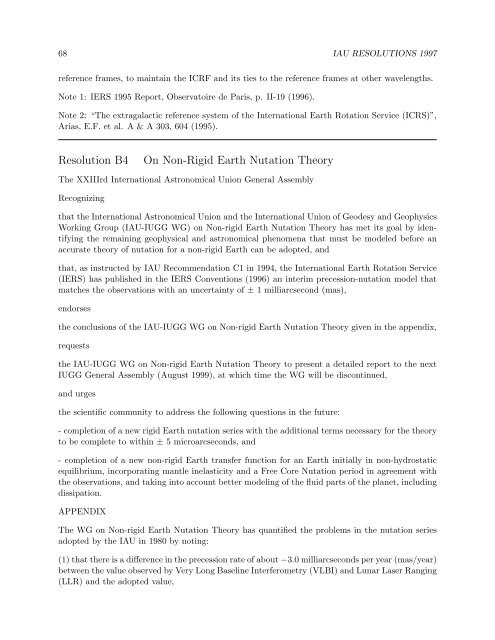USNO Circular 179 - U.S. Naval Observatory
USNO Circular 179 - U.S. Naval Observatory
USNO Circular 179 - U.S. Naval Observatory
Create successful ePaper yourself
Turn your PDF publications into a flip-book with our unique Google optimized e-Paper software.
68 IAU RESOLUTIONS 1997<br />
reference frames, to maintain the ICRF and its ties to the reference frames at other wavelengths.<br />
Note 1: IERS 1995 Report, Observatoire de Paris, p. II-19 (1996).<br />
Note 2: “The extragalactic reference system of the International Earth Rotation Service (ICRS)”,<br />
Arias, E.F. et al. A & A 303, 604 (1995).<br />
Resolution B4 On Non-Rigid Earth Nutation Theory<br />
The XXIIIrd International Astronomical Union General Assembly<br />
Recognizing<br />
that the International Astronomical Union and the International Union of Geodesy and Geophysics<br />
Working Group (IAU-IUGG WG) on Non-rigid Earth Nutation Theory has met its goal by identifying<br />
the remaining geophysical and astronomical phenomena that must be modeled before an<br />
accurate theory of nutation for a non-rigid Earth can be adopted, and<br />
that, as instructed by IAU Recommendation C1 in 1994, the International Earth Rotation Service<br />
(IERS) has published in the IERS Conventions (1996) an interim precession-nutation model that<br />
matches the observations with an uncertainty of ± 1 milliarcsecond (mas),<br />
endorses<br />
the conclusions of the IAU-IUGG WG on Non-rigid Earth Nutation Theory given in the appendix,<br />
requests<br />
the IAU-IUGG WG on Non-rigid Earth Nutation Theory to present a detailed report to the next<br />
IUGG General Assembly (August 1999), at which time the WG will be discontinued,<br />
and urges<br />
the scientific community to address the following questions in the future:<br />
- completion of a new rigid Earth nutation series with the additional terms necessary for the theory<br />
to be complete to within ± 5 microarcseconds, and<br />
- completion of a new non-rigid Earth transfer function for an Earth initially in non-hydrostatic<br />
equilibrium, incorporating mantle inelasticity and a Free Core Nutation period in agreement with<br />
the observations, and taking into account better modeling of the fluid parts of the planet, including<br />
dissipation.<br />
APPENDIX<br />
The WG on Non-rigid Earth Nutation Theory has quantified the problems in the nutation series<br />
adopted by the IAU in 1980 by noting:<br />
(1) that there is a difference in the precession rate of about −3.0 milliarcseconds per year (mas/year)<br />
between the value observed by Very Long Baseline Interferometry (VLBI) and Lunar Laser Ranging<br />
(LLR) and the adopted value,


